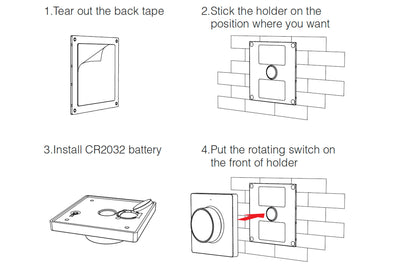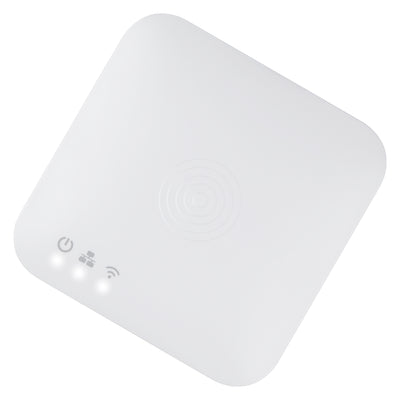
Dimmers
Dimmers are switches that adjust the brightness of lighting. They allow you to create ambience, save energy, and extend the lifespan of lamps by regulating light output. With the advent of LED lighting, dimmers have become more complex, as LEDs require different dimming techniques compared to traditional incandescent or halogen lamps.
-
 LCB-17W12,95
LCB-17W12,95 -
 Profolux B.V.
Profolux B.V.LED Remote control RGB+CCT 8 groups Excl. cover frame
-Black-220-240V24,95 -
 Profolux B.V.
Profolux B.V.LED Dimmer module Miboxer RF 2.4GHz AC Triac dimmable Excl. cover frame
-300W-220-240V-25x49x49 mm24,95 -
 LCB
LCBLED Dimmer 1-10V with remote control Excl. cover frame
-800W-220-240V34,95 -
 Profolux B.V.
Profolux B.V.LED Dimmer CCT Wireless Wall Control Excl. cover frame
-Black-220-240V19,95 -
 Ledverlichting Soest BV
Ledverlichting Soest BVLED Dim module Miboxer Zigbee 3.0 RF 2.4GHz Push Tuya Excl. cover frame
-AC 230V24,95 -
 Profolux B.V.
Profolux B.V.LED Wireless dimmer Wall control CCT Excl. cover frame
-White-220-240V19,95 -
 Ledvance
LedvanceLED Control module Zigbee Excl. cover frame
1.083,95 -
 LCB
LCBLED Driver Triac dimmable Excl. cover frame
-25W-27-42V14,95
The Different Types of Dimmers for LED Lighting
When choosing a dimmer for LED lighting, it's important to select the right type that is compatible with your specific LED bulbs. There are various dimming techniques, each with their own applications and characteristics.
| Dimming Technique | Description | Application |
|---|---|---|
| Leading Edge (TRIAC, Leading Edge) | These dimmers cut off the beginning of the alternating current sine wave. They are suitable for traditional incandescent bulbs and many dimmable halogen and some dimmable LED bulbs. Often recognized by the 'RC' marking on LED dimmers, or 'R, L' for traditional installations. | Used for resistive and inductive loads, but often also for dimmable LED bulbs. Ideal for situations where a wide dimming range is desired. |
| Trailing Edge (TRIAC, Trailing Edge) | These dimmers cut off the end of the sine wave. They are generally better suited for LED lighting because they are less likely to cause flickering or buzzing. These are often designated as 'RC' or 'R, C' on LED dimmers. | Widely applicable for dimmable LED bulbs and electronic transformers. This is the most common dimming technique for modern LED lighting in homes and offices. |
| 1-10V Dimmers | This is an analog dimming technique where a low voltage (1 to 10 volts) controls the brightness of the lamp. This method is common in professional and larger installations. | Frequently used in commercial buildings and larger projects where precise control and scalability are important, such as offices, shops, and hospitality venues. |
| Push Dimmers (with dim module) | These dimmers work with a push-switch. A short press switches on/off, while a longer press dims the lighting. The dim module itself is often placed behind the switch in the mounting box. | A practical solution for those who want to keep a modern switch or when a traditional rotary dimmer does not offer the desired functionality. |
Built-in and Surface-mounted Dimmers
Dimmers are available in different physical forms, depending on installation requirements:
- Built-in Dimmers: These are mounted inside the wall, behind the switch, or in a junction box. Designed to be discreet, they fit into standard flush-mount boxes. They are often the preferred option for a tidy finish and seamless interior integration.
- Surface-mounted Dimmers (such as plug-in or cord dimmers): These are mounted on the wall or plugged directly into an outlet. They are easy to install and suited for situations where built-in installation is not possible or for mobile lighting.
LED Dimmers and Power Supply
LED bulbs often operate at low voltage and require a LED driver (power adapter) to convert mains electricity to a suitable voltage. Some LED bulbs have an integrated driver, others require an external driver. For dimmable LED lighting, it is actually the driver that is being dimmed, not the LED chip itself. Therefore, it is important that the dimmer is compatible with the driver of the LED bulb. In the case of 1-10V dimmers, the dimmer sends a control current to the driver to adjust brightness.
Common issues with LED dimmers include flickering lights, buzzing sounds, or a limited dimming range. These problems often arise due to incompatibility between the dimmer and the LED bulb (or its integrated driver). It is crucial to choose a dimmer that is specifically designed for LED lighting and has a sufficiently wide dimming range, including adjustable minimum and maximum dim levels. Always refer to the compatibility lists from both the LED bulb and dimmer manufacturers.
Smart Dimmers for Advanced Control
Smart dimmers offer advanced control options and integration with smart home systems. They are often wireless and can be controlled via a smartphone app, voice assistants (such as Google Home or Amazon Alexa), or remote controls. These dimmers use various wireless protocols, including:
- Wi-Fi: Simple connectivity without extra hubs, directly through your existing Wi-Fi network.
- Zigbee: A popular protocol for smart home devices, often requiring a bridge or hub for communication, such as Philips Hue or IKEA Tradfri. Offers a more stable and energy-efficient network.
- Z-Wave: Another widely used smart home protocol similar to Zigbee, which also requires a hub.
- Bluetooth: Suitable for direct control within a limited range, often without a hub.
In addition to dimming, smart dimmers offer functions such as setting schedules, scenes, and adjusting light color for compatible bulbs. They enable automation, for example, turning on lighting automatically at sunset or dimming the lights when you leave a room.
When choosing a smart dimmer, make sure it is compatible with your existing smart home system, or that you are prepared to purchase a new hub. Also check the maximum wattage load the dimmer can handle to avoid overloading and damage. Some smart dimmers also offer adjustable minimum and maximum dim levels through the app, which helps prevent flickering in low wattage LED bulbs.
Frequently Asked Questions about LED Dimmers
When selecting and installing LED dimmers, common questions often arise. Here are some frequently asked topics that may help:
Why do my LED bulbs flicker when dimmed?
Flickering LED bulbs when dimmed usually indicate an incompatibility between the LED bulb and the dimmer. This may be caused by a too low minimum load for the dimmer, using the wrong dimming technology (leading edge versus trailing edge), or quality differences between components. Check if the dimmer is specifically suited for LEDs and whether the total wattage of your bulbs falls within the recommended range of the dimmer. Adjusting the minimum dim level on the dimmer may sometimes resolve the issue.
How do I prevent a buzzing sound from the dimmer?
A buzzing sound is mostly caused by electromagnetic interference, especially in older dimmers or when the dimmer's minimum load is not reached. Make sure the dimmer uses the correct dimming technique (trailing edge is generally quieter for LEDs) and that the total load of the connected bulbs is above the dimmer's minimum load. An LED compensator may sometimes help resolve this issue by increasing the load on the circuit.
Can I use a regular dimmer for LED bulbs?
In most cases, a regular dimmer designed for incandescent or halogen bulbs will not work properly with LED bulbs. Traditional dimmers are often leading edge and not matched with the low wattages and specific electronics of LEDs, which can lead to flickering, failure to dim, or even damage to the bulbs or the dimmer. Always use a dimmer explicitly suitable for LED lighting.
How do I know which dimmer I need?
The choice of dimmer depends on several factors: the type of LED bulb (dimmable or non-dimmable), the dimming technology of the bulb (TRIAC, 1-10V, DALI), the desired installation type (built-in or surface-mounted), and any smart home integration needs. Always check the product information for your LED bulbs for recommended dimmers or compatibility lists. Quality LED bulb manufacturers often publish compatibility lists with tested dimmers.







